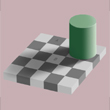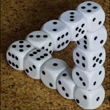Monday, 4 February 2013
Adelson’s Checkerboard
 Optical illusions are always a humbling experience for people who think that they see the world “the way it really is”. Often, when such people are confronted with optical illusions induced by context, the context has to be removed and then restored several times before these people can be convinced that, for example, two lines that appear to be different lengths are actually the same.
Optical illusions are always a humbling experience for people who think that they see the world “the way it really is”. Often, when such people are confronted with optical illusions induced by context, the context has to be removed and then restored several times before these people can be convinced that, for example, two lines that appear to be different lengths are actually the same.
The world that we see is often ambiguous, and our visual system tries to give it a meaning on the basis of certain recurrent clues. Scientists today are familiar with some of these clues and can combine them to produce some truly astounding optical illusions. One famous example is Adelson’s checkerboard, in which one square is perceived as black and another as white, even though both are actually the same shade of grey! (more…)
The Senses | Comments Closed
Monday, 9 April 2012
Better Optical Illusions
 Optical illusions are fascinating in many ways—they can create objects that cannot exist, movement in a static image, different colours with the same colour, and so on. They can also give us a better understanding of how the human visual system works, as witness this web site dedicated to the best optical illusions that scientists who study this subject have managed to devise in a contest that is held every year. (more…)
Optical illusions are fascinating in many ways—they can create objects that cannot exist, movement in a static image, different colours with the same colour, and so on. They can also give us a better understanding of how the human visual system works, as witness this web site dedicated to the best optical illusions that scientists who study this subject have managed to devise in a contest that is held every year. (more…)







